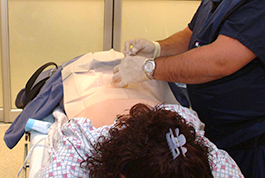-
Mark J. Downey, MD
10 Old Montgomery Hwy #200. Homewood, AL 35209
Appointments & Referrals: (205) 271-6511 - Schedule Now
 Facet Injection
Facet Injection
The facet joints are small paired joints that act as hinges in our back, connecting all the vertebral bones yet still allowing us to bend and twist with ease. Sometimes, from injury or age, these joints can become irritated or they can develop arthritis and bone spurs, which makes movement painful. Depending on which joints are involved, symptoms of facet joint pain can include neck or shoulder pain, headaches, upper or lower back pain, hip, buttock or leg pain
To relieve pain symptoms and restore range of motion, the spine physician may inject medication into or around the facet joints. The medicine injected into the facet joints can act like WD40 on a rusty door hinge, helping restore movement. Injections done around the facet joints are done to disable the sensory nerves (known as the Medial Branches) that go to the facet joints. If blocking the Medial Branch nerves is effective, a second procedure known as a Rhizotomy may be done to give a longer lasting benefit. Typically injections are done as a way to bridge the patient to therapy so the therapist can help the patient retain mobility after the effects of the medication wear off.
Facet injections are most commonly performed as an outpatient procedure. Sometimes, though not always, an IV is started if medication for relaxation is to be administered. Patients are placed face down on a special x-ray table and the skin at the injection site is sterilely prepped.  Numbing medication is then used to anesthetize the skin and tissue deep to the skin to make the procedure more comfortable. An x-ray machine called a fluoroscope is used to monitor placement of the needle or probe as well as where the medicine is being delivered. These procedures are relatively quick, taking approximately 20 minutes. Patients are monitored for a short time before being discharged home. On the day of the injection, patients are instructed not to drive and avoid strenuous activities. Some patients may experience a slight increase in pain for several days as the numbing medication wears off and while waiting for the steroid to work. The day following the injection, patients may return to their normal activities. It is important, particularly in patients undergoing medical branch block procedures, to keep a pain diary in order to maintain an accurate measure of your response to the injection.
Numbing medication is then used to anesthetize the skin and tissue deep to the skin to make the procedure more comfortable. An x-ray machine called a fluoroscope is used to monitor placement of the needle or probe as well as where the medicine is being delivered. These procedures are relatively quick, taking approximately 20 minutes. Patients are monitored for a short time before being discharged home. On the day of the injection, patients are instructed not to drive and avoid strenuous activities. Some patients may experience a slight increase in pain for several days as the numbing medication wears off and while waiting for the steroid to work. The day following the injection, patients may return to their normal activities. It is important, particularly in patients undergoing medical branch block procedures, to keep a pain diary in order to maintain an accurate measure of your response to the injection.
[Top]

Mark Downey, MD
As a physiatrist, Dr. Downey specializes in diagnosis and non-surgical treatment of pain-related spinal disorders. He is board certified in Physical Medicine and Rehabilitation (PM&R) since 2007 and uses his comprehensive spine and musculoskeletal training to determine the appropriate line of treatment for a variety of spinal conditions.
Testimonials
Home Remedy Book

As a community service, Spine Group Alabama mails out a free 36-page Home Remedy Book with customized stretches that can relieve some back and neck pain symptoms. Enter your name and address and we will mail you a copy.
Symptoms Chart

Some symptoms can become permanent if you don’t see the physician with in 24 hours. Find out when you can use “watchful waiting” and when you have an emergency symptom.
Need an Appointment?
Spine Group Alabama specializes in the treatment of back pain, neck pain, herniated discs, and all types of ligament strain related to the neck and low back. Spine Group Alabama is referred back and neck pain patients from across Alabama, including Birmingham, Tuscaloosa, Auburn, Huntsville and Montgomery.
Office Hours:
Monday - Thursday: 8am - 4:30pm
Friday: 8am - 2:30pm
Saturday/Sunday: Closed
(205) 271-6511

